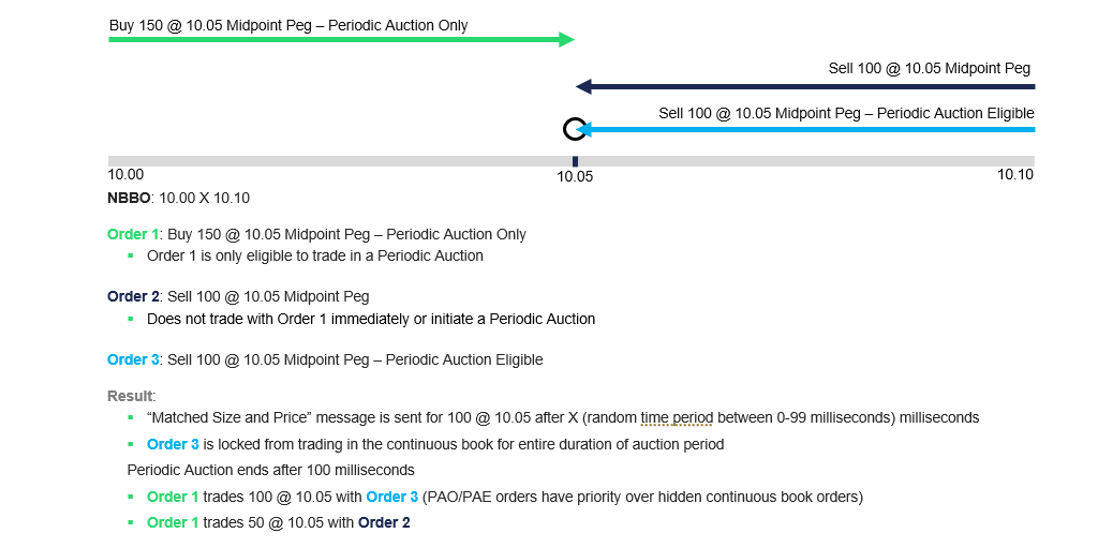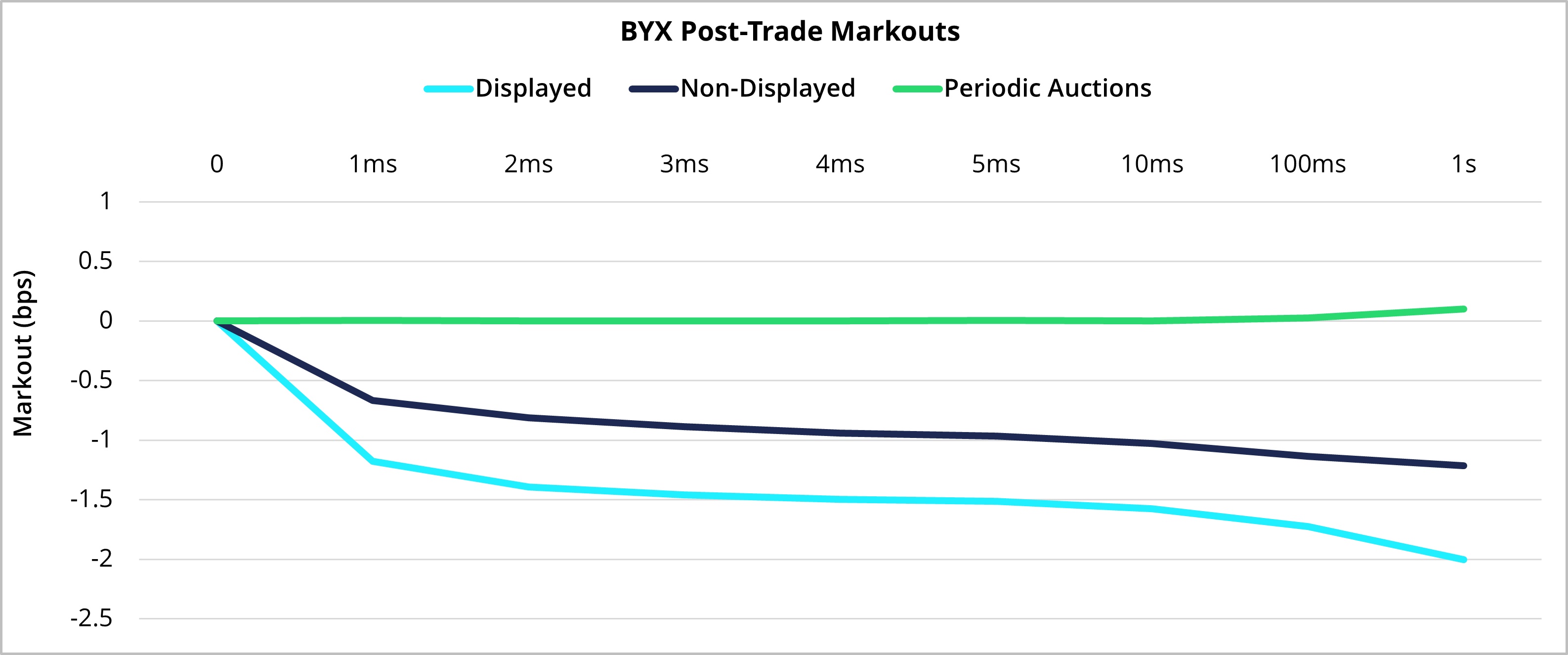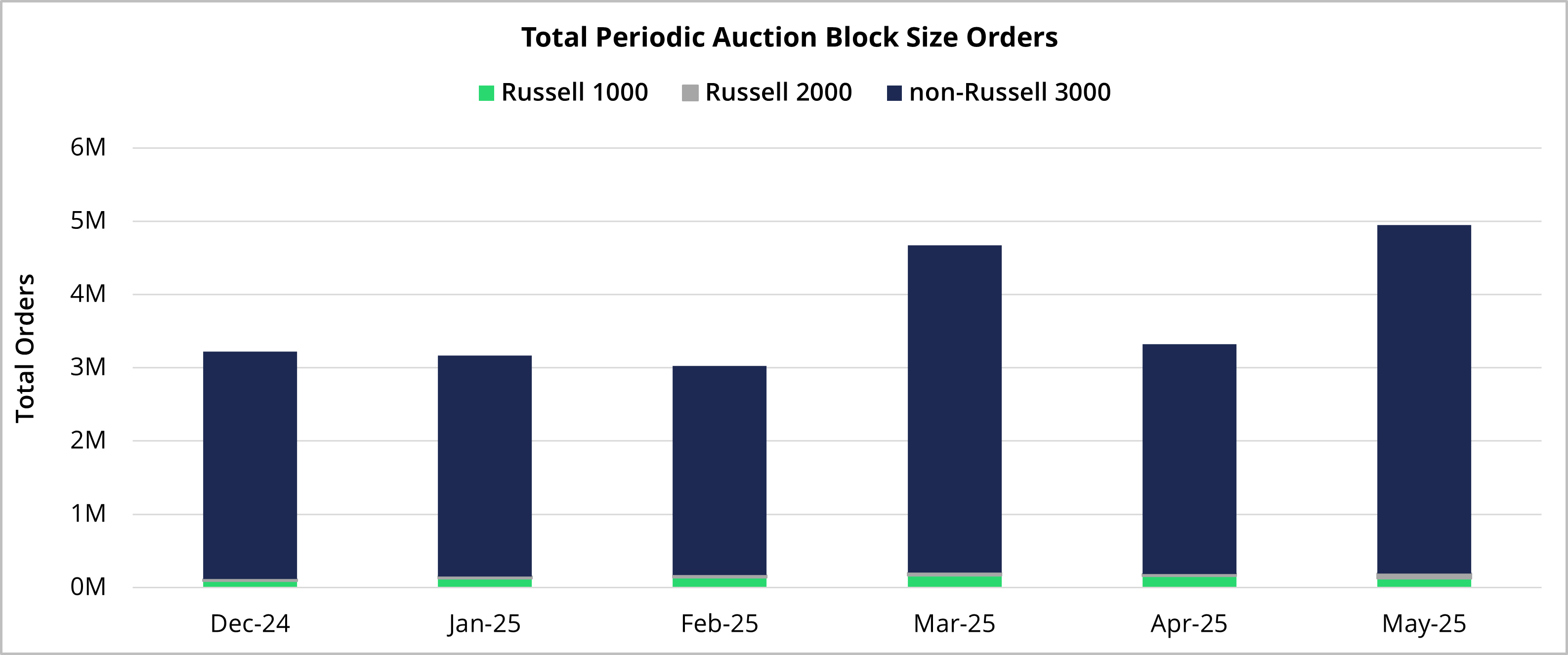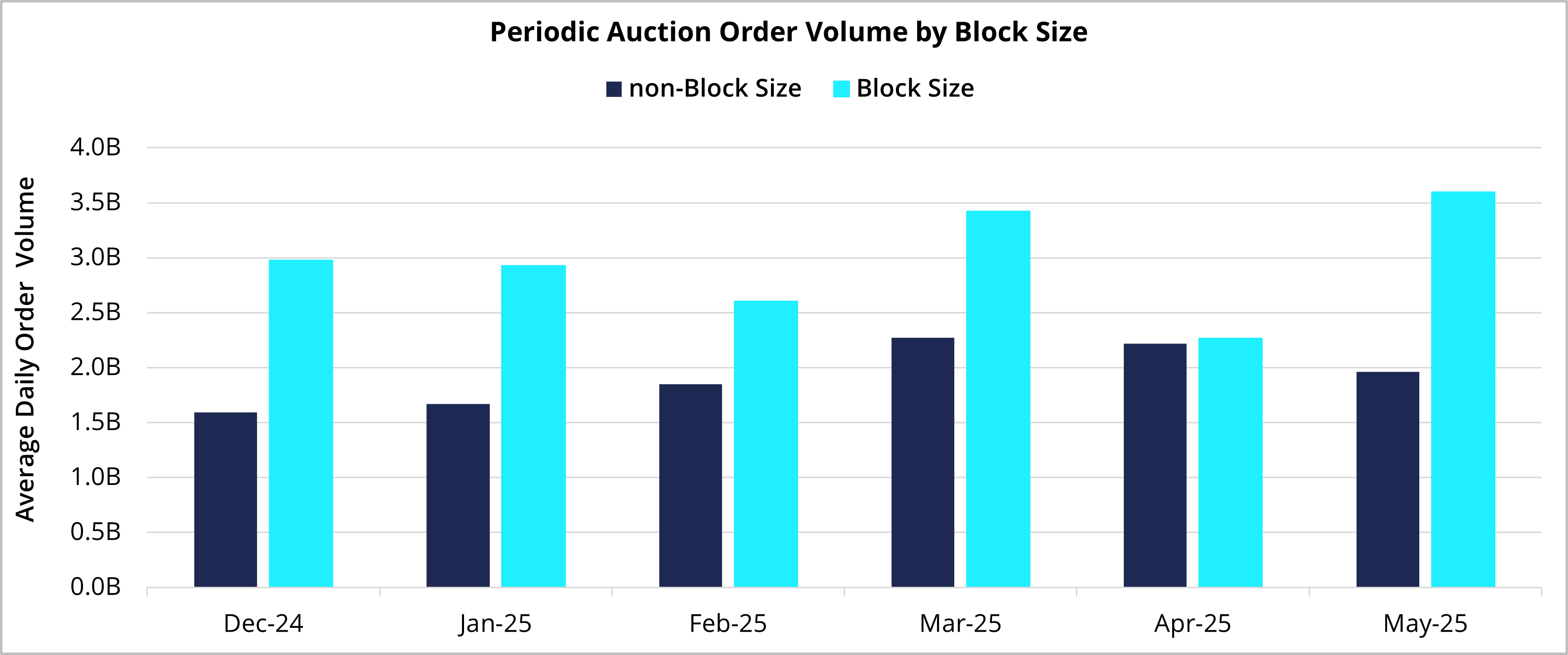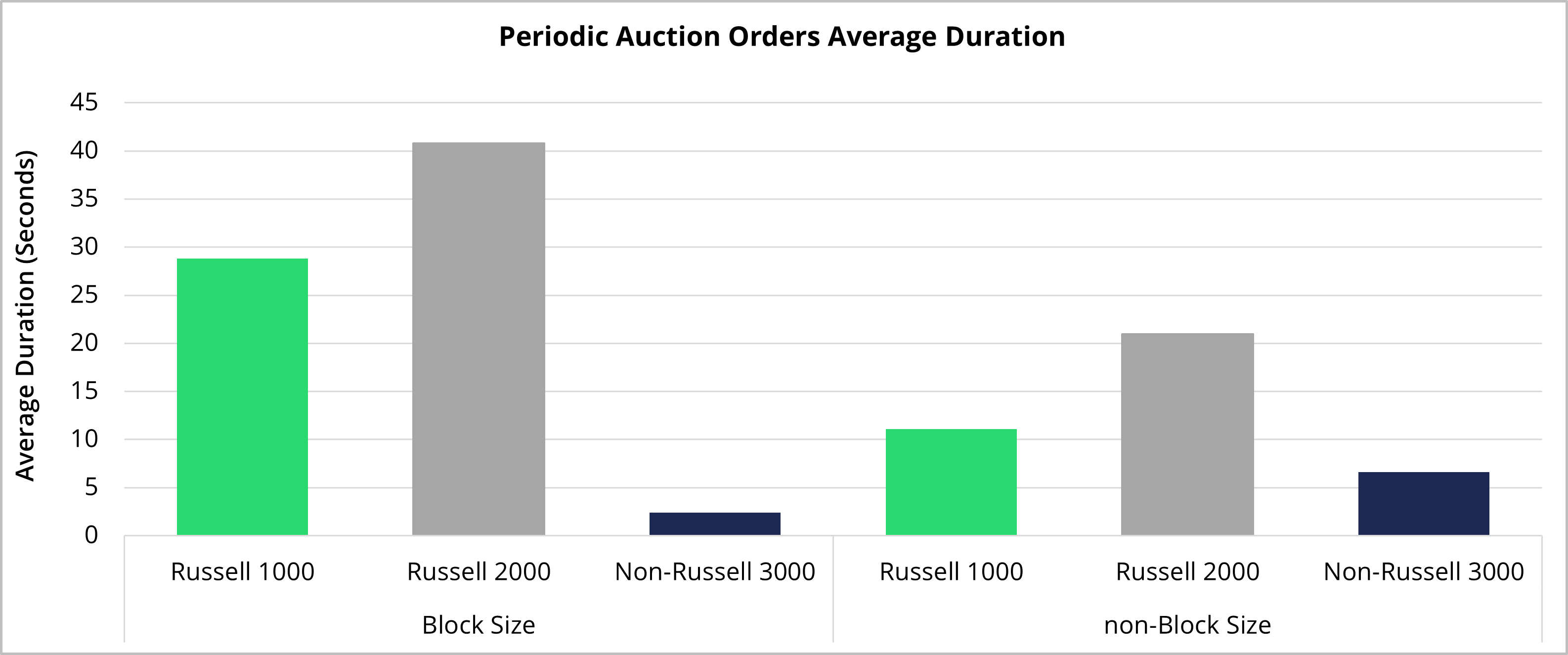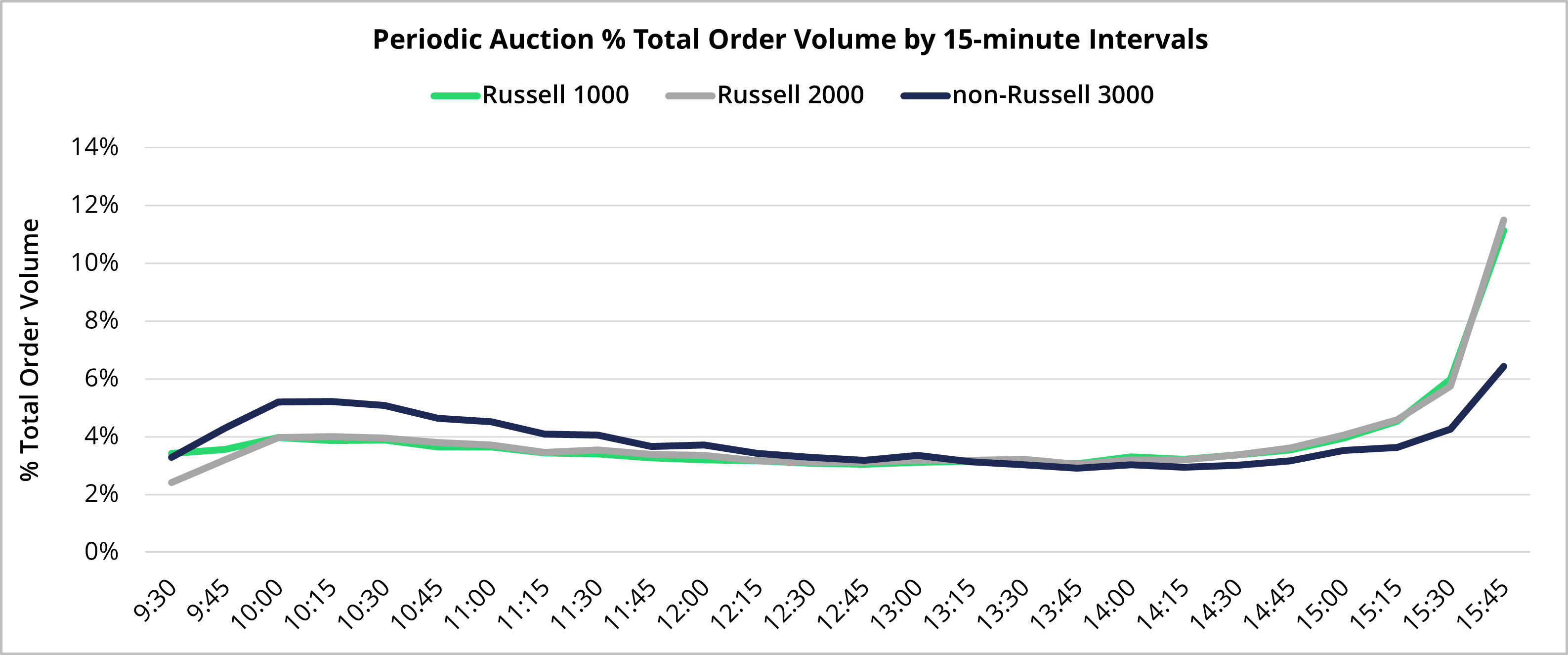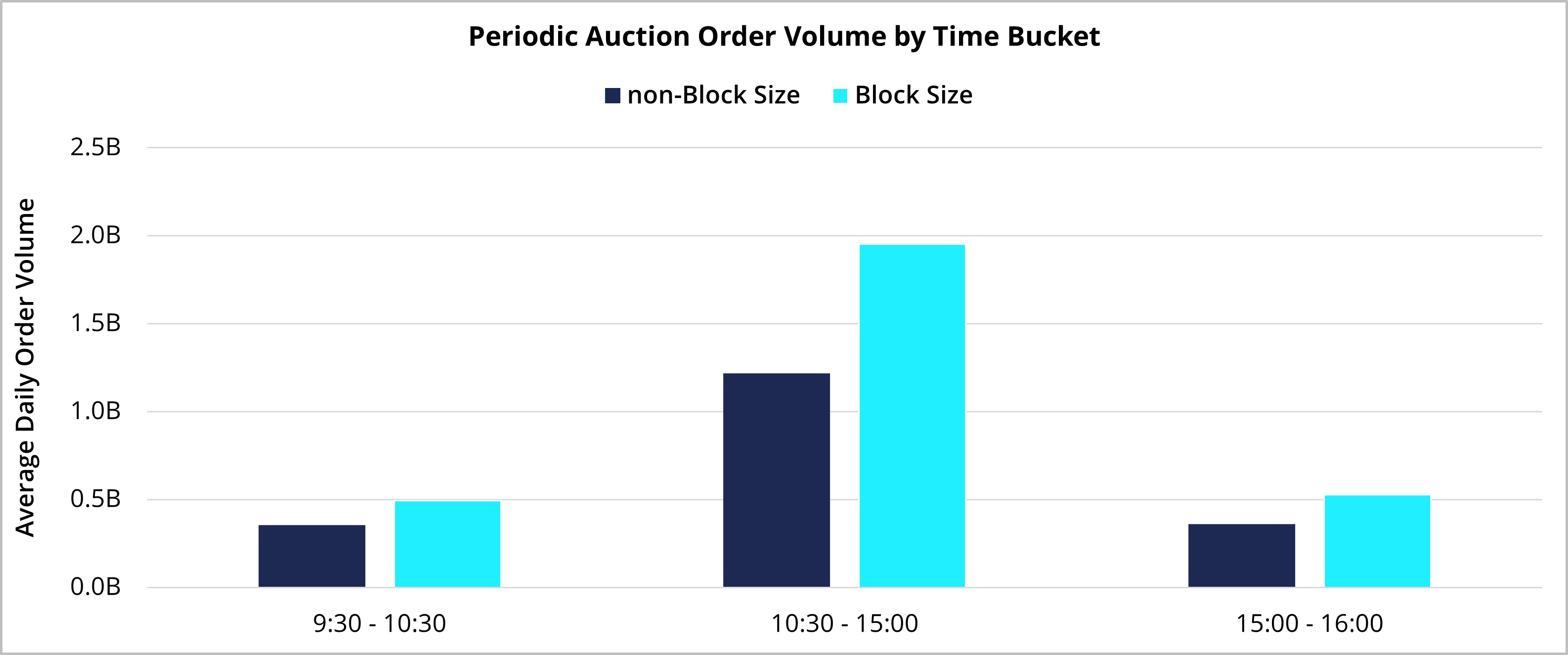Cboe’s Periodic Auctions offer a unique opportunity to source liquidity through 100 millisecond auctions triggered by crossing interest, with minimal market impact. The order allocation model rewards size over time priority, helping participants who need to manage larger trades or are seeking midpoint or other price improved fills on exchange.
In this latest Execution Consulting insights paper, we’ll dive into how Cboe’s Periodic Auctions work, execution performance and common order behaviors that have helped clients determine if the recent growth in activity can add to their liquidity seeking workflows.
How Do Cboe’s Periodic Auctions Work?
Periodic Auctions are intraday auctions that are a useful tool to attract buyers and sellers in less liquid names to reduce impact. The two order types used in Periodic Auctions, Periodic Auction Only (“PAO”) and Periodic Auction Eligible (“PAE”), are available on Cboe BYX Equities Exchange (BYX®) during the Regular Trading Session (9:30 a.m. – 4:00 p.m. ET). The example below shows when a Periodic Auction kicks off and details on how it operates.
Example: PAO order and PAE order start an Auction
Execution Performance
Not moving the market when putting on or unwinding a trade becomes more difficult if the security does not trade often. Available liquidity is harder to find, less quoting competition among market participants widens spreads and shrinks quoted depth. On top of this, there may be more market movement for larger-size trades. Periodic Auctions allow participants to source liquidity given these conditions in a wide range of securities and maintain high execution performance. Looking at the chart below, from December 2024 to May 2025, Periodic Auctions had the best mid-to-mid notionally weighted markouts in basis points compared to both displayed and non-displayed executions on BYX. Its post-trade performance remained flat to positive from 1 millisecond to 1 second after the trade and stayed above displayed and non-displayed executions by an average of 1.6 bps and 1 bps, respectively, across the eight post-trade time deltas.
Figure 1, Source: Cboe data from December 2024 to May 2025
Periodic Auctions bring natural liquidity together and pools all available interest to trade within the spread. Pairing off like-minded participants and trading at midpoint or within the spread in an auction rather than the continuous book has resulted in greater execution quality over the period.
Missed Liquidity Inside and Outside the Russell 3000 Index
Initially, Periodic Auctions were intended to improve the market quality of thinly traded securities for clients wanting to trade them. While these securities make up a large portion of Periodic Auctions, there is an increasing amount of interest in more liquid names. Periodic Auctions have seen an uptick in the number of block size orders – defined as more than 10,000 shares or $200,000 notional – hitting BYX for securities inside and outside of the Russell 3000® Index (RUA). As shown in Figure 2, there were a total of 4.95 million block size orders in May 2025, up 54% compared to December 2024. Securities not in the Russell 3000 Index comprised 96% of the orders at 4.8 million, but securities in the Russell 2000® Index (RUT) have seen the most growth. Over this period, block size orders for securities in the Russell 2000 Index grew 164% to 72,900 and orders for securities in the Russell 1000® Index (RUI) increased 41% to 121,800.
Figure 2, Source: Cboe data from December 2024 to May 2025
Not only was there an uptick in the total number of block size Periodic Auction orders, but there were similar trends in order volume. As seen in the chart below, in May 2025, Periodic Auction block size order volume increased 59% month-over-month and increased 21% from December 2024 to May 2025. In May, block size comprised 65% of Periodic Auction order volume with an Average Daily Volume (ADV) of 3.6 billion shares.
Figure 3, Source: Cboe data from December 2024 to May 2025
Periodic Auctions provide plenty of opportunities for clients to interact with different sizes of liquidity, in both the total number of block size orders and order volume by block size. Clients could reduce the time it takes to complete larger size orders and mitigate price movements by trying to locate larger liquidity found in Periodic Auctions.
Long Resting Times Provide Interaction Opportunities
We also analyzed the resting times on the book for Periodic Auction orders to see if there was enough time to interact with this flow. To compare the average duration, the chart below separates orders by block size and indices from December 2024 to May 2025. In both the Russell 1000 Index and the Russell 2000 index, block size orders sat longer on the book. On average, there was a gap between block size and non-block size resting times of 17 seconds and 20 seconds for the Russell 1000 Index and Russell 2000 Index, respectively. Also, when looking at block size and non-block size orders separately, the Russell 2000 Index had the highest average duration in both categories when compared to the other indices. Periodic Auction orders were resting for an average duration of at least 9 seconds, long enough for participants to match against, especially in large-cap and small-cap securities, as well as for trades of different sizes.
Figure 4, Source: Cboe data from December 2024 to May 2025
Peak Times for Interaction
Lastly, the below shows the percentage of Periodic Auction orders sent to the book to identify parts of the trading day that offer the largest potential liquidity. As shown in Figure 5, Periodic Auction order volume predominately follows the common smile curve seen in the U.S. cash equities market. However, a notable exception occurs from 9:30 – 10:15 a.m. when the amount of order volume within the non-Russell 3000 Index securities rises to make up 18% of the total volume. The highest percentage of Periodic Auctions in a 15-minute interval occurs at 15:45 p.m., which captures 6.4% of volume, followed by the 10:15 a.m. interval at 5.2%. Additionally, there is a sharp increase heading into the last 45 minutes before the market close where both the Russell 1000 Index and Russell 2000 Index Periodic Auctions cumulative totals represent session highs of 21.7% and 21.8%, respectively.
Figure 5, Source: Cboe data from December 2024 to May 2025
While peak times of interest for Periodic Auctions are near the start and end of the core session, bucketing the trading day into three intervals showed a large amount of liquidity between the peak times. In Figure 6, the average daily order volume from 10:30 a.m. to 15:00 p.m. was 1.2 billion shares for non-block size and 1.9 billion shares for block size. Both were larger than the first and last hour buckets, as liquidity midday was more than 850 million and 1.4 billion shares greater for non-block and block size liquidity, respectively.
Figure 6, Source: Cboe data from December 2024 to May 2025
The distribution of order volume for Periodic Auctions offers additional opportunities to find liquidity near the beginning and end of the trading day. Leading up to the close, all securities order volume increased with securities inside the Russell 3000 index showing a more pronounced rise. Also, securities outside the Russell 3000 index grew right after the open before leveling off. Even with these spikes of interest, liquidity appeared elsewhere in the session and a large amount of non-block and block size interest showed up at midday. These liquidity profiles can help complement market participants’ activity during the middle of the day along with the two most significant liquidity events of the core session.
Enhancing Trading Solutions with Periodic Auctions
Periodic Auctions are an on-exchange solution to meet customer demand for a differentiated choice in which to source liquidity. Cboe’s offering provides a way to trade in greater size, reduce market impact and support price discovery. Periodic Auctions bring more opportunities for clients to find a solution within their current workflow with a wide range of names and common order behaviors. Additionally, by utilizing port defaults, there’s minimal operational lift needed to begin interacting with Periodic Auctions, and the upside is measurable.
Please reach out to Cboe’s North American Cash Equities Team with questions and to learn about how we can help optimize your trading experience. Don’t forget to ask to sign up for our weekly Periodic Auctions missed opportunities report to stay up to date.
There are important risks associated with transacting in any of the Cboe Company products discussed here. Before engaging in any transactions in those products, it is important for market participants to carefully review the disclosures and disclaimers contained at: These products are complex and are suitable only for sophisticated market participants. In certain jurisdictions, Cboe Company products are only permitted for investment professionals, certified sophisticated investors, or high net worth corporations and associations. These products involve the risk of loss, which can be substantial and, depending on the type of product, can exceed the amount of money deposited in establishing the position. Market participants should put at risk only funds that they can afford to lose without affecting their lifestyle. © 2025 Cboe Exchange, Inc. All Rights Reserved.


